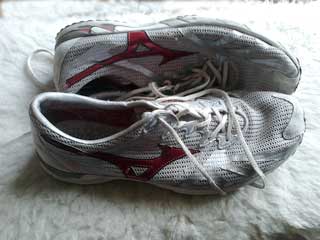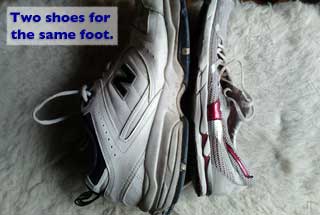Feature Article
See Shoes Run

Running is a popular form of training, and it should be. It is, after all, one of the most natural movements we can
perform and one that can not only come in handy (say, for catching a bus), but can even save your life (say, by running
out of the way of a bus).
I must confess, I'm not crazy about running, so I don't do as much of it as I should. I'm also not a distance runner: five
miles is pretty much my limit, and I much prefer doing sprints or a fast mile. But that's not important.
What is noteworthy is that I've had cranky knees since I was a teenager. You know, for 20 years or so. Anyway, one thing that
would reliably aggravate them was running on hard surfaces. I found running on dirt (like the
Bridle Path in Central Park) tolerable,
but anything other than a sprint on asphalt would sound the crankiness bells within 30 seconds. Even treadmill running was
problematic, though not as bad as asphalt. ("Asphalt" is a funny word. Say it: "Asphalt." Heh.)
I'd been reading about barefoot running for quite a while, ever since a
2006 article on the Tarahumara Indians in Men's Health.
(I have to give that mag some props, although I don't subscribe any more. They were sometimes ahead of the curve.) When
Born to Run came out in 2009 (also about the Tarahumara) and kickstarted the
barefoot running craze (well, maybe not a craze), I finally started seriously considering giving it a try (although I never read the book).

But I didn't want to run barefoot, just barefoot-ish. The freakish
Vibram FiveFinger
shoes were gaining popularity, but they didn't mesh with
my keen fashion sense. After doing some research, I decided to go with
Mizuno Wave Universe 3 (pictured, but no longer available) racing flats which actually weigh less than the
Vibrams but still look pretty cool (except for the
pinkish hue).
They took their debut run along the
East River Walk on May 2, 2010. (I found
that on the awesome
blitzometer.com which StrongFast uses for scheduling and tracking all our training.) It was a short
run, because the word was this kind of running can cause calf and foot cramping, especially in the early stages. (Believe it.) The first thing I noticed was the speed. Yes,
they're racing flats, but I was still running much faster than usual and it was easy. The second thing was the lack of knee pain. Hooray!

So what's the big deal with the shoes? Well, besides being very light and very flexible (which allows the arch of your foot to do its thing), the heels are not raised, or
are raised only slightly. This is much different from the standard running shoe with its heavily padded heel. The standard raised heels do two things: they cushion the
heels of your feet so it doesn't hurt to run on them, and they promote heel-strike running (where the heels are the first part of the foot to make contact with the road)
since the heels are so large (compared to flats or bare feet). Barefoot running
proponents argue that striking with the heels first is not the way we were meant to run; only the heavily padded shoes allow it to happen. And indeed, if you
try running barefoot you won't run heel-first, at least not for long. It hurts! But they also contend that striking that way jars the body through the knees,
hips, and back leading to pain and injury.
There are, of course, critics of these contentions. But it's hard to argue that the mid-foot-striking style of running that is associated with running
barefoot (or with minimalist shoes like racing flats and Vibrams) is how we were meant to run. A common counter is that humans didn't evolve running on
asphalt and concrete, but it's not like the world was all comfortably carpeted grasslands; indeed, the Tarahumara live and run in rocky canyons. But anyway,
the important thing is ... does it help?

The only way to know is to try it yourself. If you don't want to sink cash into special shoes, you can try running literally barefoot, or in socks on a
treadmill (the treads tend to be like sandpaper on bare feet). But all the major running shoe companies now offer minimalist shoes, so you might be able
to find a reasonable deal. I have a pair of Vibrams (pictured, although I still prefer the Mizunos) and a skeptical buddy ("Captain Incredulous") recently picked up
a pair of
Skechers GOruns (stupid name) on the recommendation of a friend who owns a running
shoe store. (The Captain is now a convert.)
So if you have joint pain when running--or even if you don't--it's worth trying a minimalist shoe to see how it works for you. Remember to run on your mid-foot
rather than the heel (it might take a little getting used to), and start with very short runs as it will make your feet and calves work harder than usual (and
that's a good thing). Now when I wind up having to run in my old New Balance walking shoes, they feel like Frankenstein boots. No wonder my knees objected!
Be seeing you.
-gary
PS This can give you an edge in the Spring Spring Thing Challenge!